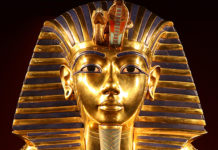An exploration of the emergence of social complexity in the Nasca civilization, through polychrome ceramics, geoglyphs, and ceremonial centers.
Symbolic objects served many purposes for the Nasca in that they facilitated communication between individuals, within various groups, and between polities, signifying relations of dependency, affiliation, or correspondence for the Nasca civilization. Elites may therefore have used materialization of ideology in order to further their claims of superiority or leadership. In return, this tangible ideology is then disseminated in order to spread belief and influence others.
In addition, public monuments associate a group with a place and represent the power and authority of its leaders. Monumental architecture is an important index of social complexity in that it serves as an enduring symbol of a society’s beliefs. The materialization of ideology in all of its forms invests social capital to achieve specific objectives, in the form of creating solidarity, social cohesion, or group identity, while also legitimating leadership through perpetuating images of corporate power. This materialization can also be a cause of significant societal changes as elites compete for resources and prestige.
Materializing Ideology in the Nasca Civilization
As is evident from the model above, materialization of ideology takes numerous forms and serves many functions. Although there are three different foundations of power-building, which are the use of economic resources, physical force, and ideology, the latter is often the most effective means of acquiring power and prestige, according to archaeologist David Vaughn. In the Nasca civilization, ideologically charged material was used to create alliances and solidify religious beliefs.
By transforming values, ideas, and political affiliations into a tangible reality, elites were able to negotiate power and control access to knowledge and ideas. Such materialization occurred during the Nasca civilization in forms such as the production and distribution of polychrome pottery, the creation and ceremonialism of the site of Cahuachi, and the prevalence and iconography of the geoglyphs found throughout the Nasca region.
The Spread of Ideology through Ceramics
The ceramic tradition of the ancient Nasca enabled tangible ideology to spread to vast regions in the form of complex iconography. In addition, these polychrome ceramics were used and consumed in a variety of situations. Such a craft economy was crucial to the foundations of early elite power in Nasca, established during the Early Nasca period.
Based on the lack of institutionalized stratification in settlement patterns and analysis of burials, sociopolitical leadership was not highly centralized in Early Nasca. Rather, status was likely very flexible and involved political acts and displays at centers like Cahuachi. Because status was so fluid in Nasca society, Cahuachi was an important means of institutionalizing privilege through ritual ceremony, incorporating the consumption of polychrome ceramics in feasting, according to Vaughn.
Nasca Trophy Heads and Other Popular Motifs
Indeed, most of this institutionalization was done through controlled ideology; it does not appear that coercive force was used very extensively in Nasca to obtain elite privilege. While one popular iconographic motif – the trophy head – offers suggestions of apparent violence, there is actually very little evidence to support this hypothesis. David Vaughn explains that an analysis of trophy heads from cemeteries in the Las Trancas Valley suggests that most of these from the Early Nasca are not related to warfare, since there are many women and children present in the sample. Rather, these trophy heads were simply another aspect of materialized ideology, perhaps symbolically linked to fertility.
For example, numerous symbols such as the Sprouting Head motif are found on Nasca polychromes in which plants that grow directly out of heads are depicted. Moreover, entire caches of trophy heads have been found, indicating that they served a religious or ideologically charged role in Nasca society.
In addition, because Cahuachi was not a permanent residential area and the Nasca occupied this center predominately for pilgrimage, the distribution of ceramic vessels from Cahuachi ensured that religious and political doctrine in the form of pottery be spread to all regions of the Nasca civilization subsequent to the ceremonial activities. This effect allowed early elites to maintain their achieved status in society and influence a wider range of people.








